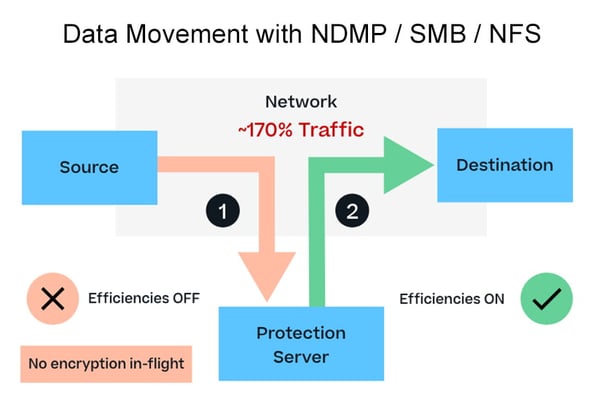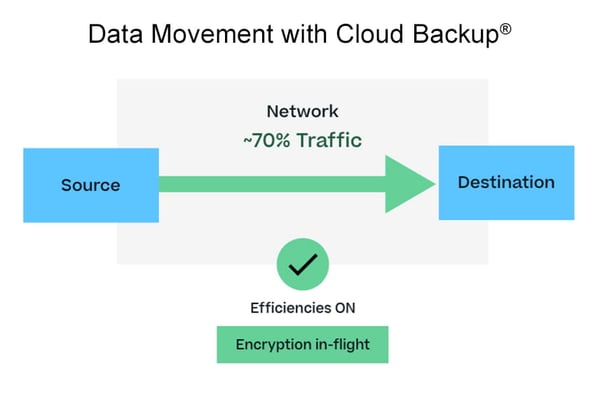Subscribe to our blog
Thanks for subscribing to the blog.
July 14, 2022
Topics: Cloud Backup File ServicesData ProtectionBackup and ArchiveAdvanced5 minute read
Backup data is a must-have insurance policy for any organization. But backup systems that rely on media gateways can be too slow and insecure to create reliable copies. That kind of delay can lead to missed backup windows. For critical NAS backups, you’ll need a more reliable backup solution.
In this blog, we’ll look at common challenges associated with indirect backup architectures along with how NetApp’s direct backup solution—Cloud Backup—can help address these challenges.
Read on below as we cover:
- Data Movement Challenges with Indirect Backups
- Direct Backup with Cloud Backup
- The Benefits of Direct Backups Using Cloud Backup
- Conclusion
Data Movement Challenges with Indirect Backups
Data backup architectures with the Network Data Management Protocol (NDMP) or native Server Message Block (SMB) and Network File System (NFS) services leverage an intermediate backup media gateway. With this architecture, backup data is first stored in an intermediate protection server/media gateway before moving to its ultimate backup storage destination. Note that this means NDMP can’t directly leverage the cloud.

When the data size is small, this kind of architecture likely won’t pose a significant challenge. However, as the data estate grows, additional overhead is required for the backup process for a few reasons:
- Transferring data to the backup storage destination involves two hops. When backing up from storage solutions like NetApp ONTAP, which provide enhanced storage efficiencies through proprietary deduplication, compaction, and compression features, this media gateway could nullify those storage efficiencies. That means the storage space required to keep the backup data sets will keep increasing over time. It could also put additional stress on the network to transfer needlessly large volumes of data.
- There’s a significant impact on the production environment’s performance due to the additional processing power required for NDMP-based backups. Since the performance is unpredictable, customers might be forced to build redundant infrastructure for backup purposes. For example, as data volume increase every year, you might need to upgrade your network or buy additional storage capacity for the intermediate media gateway itself.
- If the backup has multiple data streams, the process can be very slow due to the single data stream per NAS node limitation of NDMP. For big sets of data, full backups can take extremely long amounts of time to back up, resulting in subsequent backup windows being missed, leaving you with fewer recovery points in the event of data loss.
- There is a greater security risk where there are redundant copies of data created in the process without encryption in-flight. In this case, the data in-flight to the media gateway could be accessed by a threat vector and become susceptible to theft.
- There’s no backstage access to storage. The backup solution must be able to read the file system from the NAS storage via native file protocols such as SMB or NFS, or via NDMP.
- File-level backups come with additional constraints, such as the number of files, file size, open files, etc. This makes the backup data movement process inconsistent and unreliable. The organizational RPO and RTO would be tough to meet, especially for larger data volumes, whereas block-level backups only require copying changed blocks from the previous backup.
Considering the above facts, using a media gateway for backup is like using Robocopy to replicate data between locations in typical backup architecture. There are no further storage economies, security, or performance advantages. For organizations with large data estates, this would significantly lower the overall ROI.
Direct Backup with Cloud Backup
NetApp Cloud Backup helps address the above backup challenges for your on-premises ONTAP storage solutions as well as in the cloud. Data is stored directly in object storage in AWS, Azure, Google Cloud, or in the on-prem NetApp StorageGrid® appliance. NetApp Cloud Backup provides a quick and easy way to create backups of ONTAP NAS storage while preserving all the storage efficiencies offered by the platform.
Cloud Backup provides you with an option to back up data from ONTAP directly to object storage, eliminating the requirement of a media gateway.

The Benefits of Direct Backups Using Cloud Backup
There are a number of benefits to direct backups with Cloud Backup:
No loss of ONTAP storage efficiency: As the media gateway is eliminated in the Cloud Backup architecture, it helps preserve storage efficiencies natively offered by ONTAP through features like deduplication, compression, and compaction. Combined with the incremental-forever approach for backups, it generates less than 70% of network traffic compared to NDMP-based backups and is also 100 times faster.
Automated backup creation: Incremental backups from block storage to object storage are enabled in the backend through NetApp’s Snapshot™ and SnapMirror® data replication technologies. These features are used transparently to create backups and transfer them between ONTAP systems.
Cloud Backup’s SnapMirror Cloud functionality is orchestrated centrally from Cloud Manager. This allows for a SaaS-based single-pane management option for the ONTAP suite of products. You can schedule and manage backups of your heterogeneous ONTAP infrastructure both on-prem and in the cloud directly from the Cloud Manager interface.
Faster, more reliable backup creation: Scanning and backup times in NetApp Cloud Backup are decreased compared to NDMP-based backup solutions. This reduces the backup window significantly, even for larger data sets, speeding up the process and ensuring your backups are always up to date. Faster backup cycles help increase backup frequency and eliminate the concern of skipped backups, thereby ensuring that you can meet your recovery point objectives.
Granular restore: As the backup process is block-based, your data recovery can also be more granular, so only the data that needs to be restored is transferred.
A NetApp-native solution: If you’re using ONTAP solutions, Cloud Backup offers native backup support from the same vendor, simplifying your budget management and support processes. Combined with the convenience offered by Cloud Manager, the operational overhead associated with managing the backup of large datasets is also reduced.
Conclusion
Cloud Backup will help you get rid of clunky media gateway-based backup systems and allows you to take advantage of using object storage directly as a backup target. Additionally, you can also reap the benefits of enhanced security features, indexed catalog-based search, ransomware protection through immutable backups, along with a wide range of supported workloads, all provided as a managed service from NetApp’s Cloud Backup.

